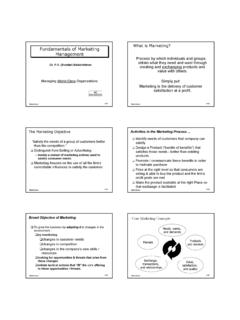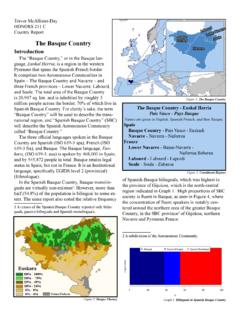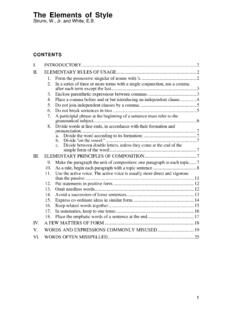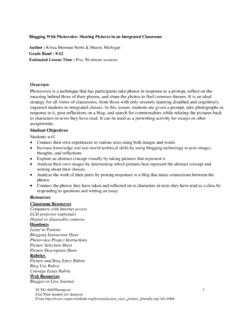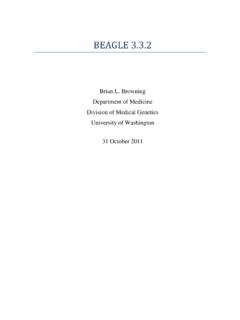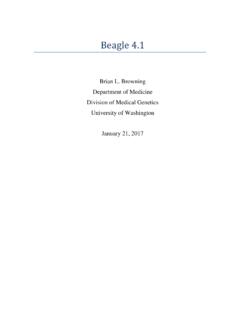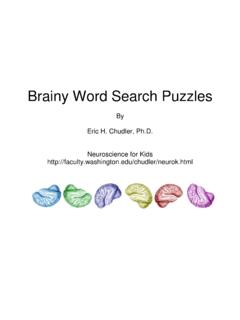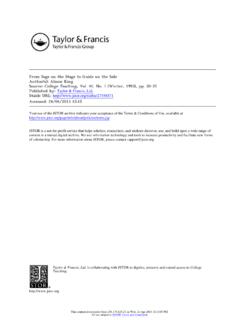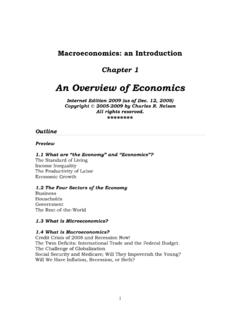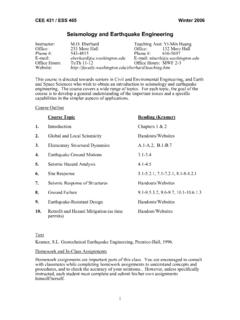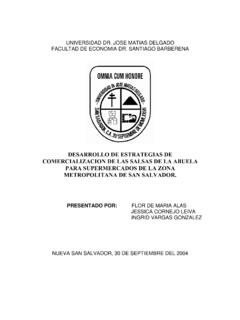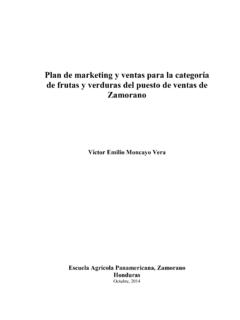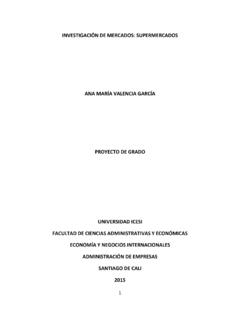Transcription of When Choice is Demotivating: Can One Desire Too Much of a ...
1 When Choice is Demotivating: Can One Desire Too Much of a Good Thing? Sheena S. Iyengar Columbia University Mark R. Lepper Stanford University Current psychological theory and research affirm the positive affective and motivational consequences of having personal Choice . These findings have led to the popular notion that the more Choice , the better--that the human ability to manage, and the human Desire for, Choice is unlimited. Findings from 3 experimental studies starkly challenge this implicit assumption that having more choices is necessarily more intrinsically motivating than having fewer. These experiments, which were conducted in both field and laboratory settings, show that people are more likely to purchase gourmet jams or chocolates or to undertake optional class essay assignments when offered a limited array of 6 choices rather than a more extensive array of 24 or 30 choices.
2 Moreover, participants actually reported greater subsequent satisfaction with their selections and wrote better essays when their original set of options had been limited. Implications for future research are discussed. Ne quid nimis. (In all things moderation.) --Publius Terentius Afer (Terence), c. 171 It is a common supposition in modern society that the more choices, the better--that the human ability to manage, and the human Desire for, Choice is infinite. From classic economic theo- ries of free enterprise, to mundane marketing practices that provide customers with entire aisles devoted to potato chips or soft drinks, to important life decisions in which people contemplate alternative career options or multiple investment opportunities, this belief pervades our institutions, norms, and customs. Ice cream parlors compete to offer the most flavors; major fast-food chains urge us to "Have it our way.
3 " Sheena S. Iyengar, Graduate School of Business, Columbia University; Mark R. Lepper, Department of Psychology, Stanford University. We gratefully acknowledge the cooperation and assistance of Draeger's Grocery Store located in Menlo Park, California, for generously offering their store as a field site for conducting Study 1. Similarly, Study 2 could not have occurred without the cooperation and support of Claude Steele at Stanford University who generously allowed his introductory social psy- chology course to be used as a forum for conducting this field experiment. Further, we would like to thank the numerous graduate students in the Department of Psychology at Stanford University and undergraduate re- search assistants who generously dedicated their time and effort to help conduct these studies. Correspondence concerning this article should be addressed to Sheena S.
4 Iyengar, Columbia University, Graduate School of Business, Uris Hall- Room 714, 3022 Broadway, New York, New York 10027-6902, or to Mark R. Lepper, Department of Psychology, Jordan Hall-Building 420, Stanford University, Stanford, California 94305-2130. Electronic mail may be sent to or On the face of it, this supposition seems well supported by decades of psychological theory and research that has repeatedly demonstrated, across many domains, a link between the provision of Choice and increases in intrinsic motivation, perceived control, task performance, and life satisfaction (Deci, 1975, 1981; Deci & Ryan, 1985; Glass & Singer, 1972a, 1972b; Langer & Rodin, 1976; Rotter, 1966; Schulz & Hanusa, 1978; Taylor, 1989; Taylor & Brown, 1988). In a typical laboratory study, the intrinsic moti- vation of participants is compared across two conditions: one in which participants are given a Choice among half a dozen possible activities, and a second in which participants are told by an experimenter which specific activity to undertake (Zuckerman, Porac, Lathin, Smith & Deci, 1978).
5 The recurring empirical finding from these studies is that the provision of Choice increases intrinsic motivation and enhances performance on a variety of tasks. Moreover, the positive consequences of Choice are often appar- ent even in contexts where the Choice itself is trivial or incidental (Cordova & Lepper, 1996; Dember, Galinsky, & Warm, 1992; Swann& Pittman, 1977). Indeed, many important theories in social psychology, including attribution theory ( , Kelley, 1967, 1973), dissonance theory ( , Collins & Hoyt, 1972; Cooper & Fazio, 1984; Linder, Cooper, & Jones, 1967), and reactance theory ( , Brehm, 1966), all presume that even purely illusory percep- tions of Choice will have powerful effects (Langer, 1975; Lefcourt, 1973; Lewin, 1952). Although prior research has made a compelling case for the psychological benefits of the provision of Choice , there remain some potential limitations to this literature.
6 Consider one seem- ingly trivial, yet potentially important, methodological character- istic of prior studies: that the number of options presented in Journal of Personality and Social Psychology, 2000, Vol. 79, No. 6, 995-1006 Copyright 2000 by the American Psychological Association, Inc. 0022-3514/00/$ DOI: 995 996 IYENGAR AND LEPPER previous experiments was characteristically small, typically be- tween two and six alternatives. It would appear, then, that what prior research has actually shown is that Choice among relatively limited alternatives is more beneficial than no Choice at all. Pre- sumably, of course, constraints on the number of options offered in past Choice studies were imposed primarily for the sake of conve- nience; however, real-world situations often provide more than a limited selection, sometimes even an overwhelming number of options. What happens when the range of alternatives becomes larger and the differences among options become relatively small?
7 Certainly, there are cases when even a vast array of choices may still have beneficial effects. Imagine a group of people who arrive at a new restaurant, for example, all hoping to order their personal favorite dishes. Obviously, the more items offered on the menu, the more satisfied these customers will be, on average. More generally, in preference-matching contexts, in which people enter hoping to find some particular product or service they already know themselves to prefer, larger numbers of options should increase the likelihood that they will be successful in their search. On the other hand, a growing body of research also suggests that people can have difficulty managing complex choices. To begin with, research has shown that as the attractiveness of alternatives rises, individuals experience conflict and as a result tend to defer decision, search for new alternatives, choose the default option, or simply opt not to choose (Dhar, 1997; Shafir, Simonson, & Tver- sky, 1993; Shafir & Tversky, 1992).
8 Furthermore, consumer re- search suggests that as both the number of options and the infor- mation about options increases, people tend to consider fewer choices and to process a smaller fraction of the overall information available regarding their choices (Hauser & Wernerfelt, 1990). In fact, studies show that the selection, evaluation, and integra- tion of information are all clearly affected by the available number of options; this suggests that, as the complexity of making choices rises, people tend to simplify their decision-making processes by relying on simple heuristics (Payne, 1982; Payne, Bettman, & Johnson, 1988, 1993; Timmermans, 1993; Wright, 1975). For instance, a comparison of the decision strategies of people pre- sented with three, six, or nine alternatives revealed that 21% used an elimination strategy in the case of three options, 31% used an elimination strategy in the case of six options, and 77% used an elimination strategy when there were nine options (Timmermans, 1993).
9 The increase in the percentage of participants who used an elimination strategy as the number of alternatives grew was also accompanied by a decrease in the percentage of information used. This sharp decrease in the number of attributes considered as problem complexity increases suggests that information overload may produce a change to a noncompensatory but more efficient decision rule. The three studies presented in this article, therefore, examine for the first time the possibility that there may be differential motiva- tional consequences of encountering contexts that offer a limited ( , psychologically manageable), versus an extensive ( , psy- chologically excessive), number of choices. Specifically, the Choice overload hypothesis underlying these studies is that, al- though the provision of extensive choices may sometimes still be seen as initially desirable, it may also prove unexpectedly demo- tivating in the end.
10 In these studies, limited- Choice conditions were operationalized as contexts that offered roughly the same number of options (approximately six) as used in past research ( , Zuckerman et al., 1978). In comparison, extensive- Choice conditions were opera- tionalized as contexts in which participants would have some reasonably large, but not ecologically unusual, number of options. In addition, to provide a clear test of the Choice overload hypothesis, several additional methodological considerations seemed important. On the one hand, to minimize the likelihood of simple preference matching, care was taken to select contexts in which most participants would not already have strong specific preferences. On the other hand, to minimize the potential impor- tance of effortful information search, care was also taken to select tasks for which "right" and "wrong" choices would be subjective, so that the effort involved in making a Choice would be largely a function of personal preferences.
